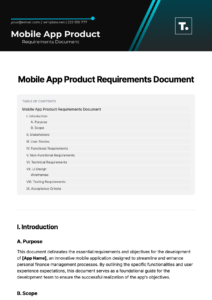Crafting a robust mobile application requires a clear and detailed requirements document. It serves as the cornerstone of your development process, ensuring that the app meets the needs of both users and stakeholders. This comprehensive guide will provide you with a step-by-step process for creating an effective requirements document template for your mobile application.
Defining the Scope and Objectives
The initial step involves defining the scope and objectives of your mobile application. This includes identifying the problem you’re aiming to solve, the target audience, and the key features and functionalities required. Clearly define the business requirements and goals that the app will address. A well-defined scope will ensure that the development team has a clear understanding of the project’s objectives and can prioritize features accordingly.
To effectively define the scope, consider conducting thorough market research, user surveys, and competitive analysis. By understanding the market landscape and user needs, you can determine the critical features that will set your app apart. Furthermore, involve stakeholders, such as clients, end-users, and technical experts, to gather their insights and ensure that the requirements align with the overall business strategy.
Detailed Feature Specifications
Once the scope and objectives are established, it’s crucial to outline the detailed feature specifications. This section includes defining each feature’s functionality, user interface, and technical requirements. A well-structured requirements document template will guide the development team in understanding the specific requirements of each feature, including its purpose, behavior, and dependencies.
Describe the user interface, including screen layouts, navigation, and interactions. Clearly specify the data flow and any integrations with external systems. Additionally, address performance requirements, such as response time, scalability, and data storage considerations. By providing comprehensive feature specifications, you ensure that the development team has a thorough understanding of the app’s expected behavior.
Non-Functional Requirements
In addition to functional requirements, non-functional requirements are equally important and should be clearly outlined in the requirements document. These requirements encompass aspects such as security, accessibility, usability, reliability, performance, and maintainability. Define the security measures required to protect user data and ensure compliance with regulations.
Consider accessibility guidelines to ensure the app is inclusive for users with disabilities. Address usability principles to enhance the user experience, including intuitive navigation and clear user interfaces. Specify performance targets, including response time, resource utilization, and scalability. Define maintenance and support requirements to ensure the app remains functional and up-to-date. By addressing non-functional requirements, you guarantee that the app meets the desired quality standards.
Conclusion
Creating a comprehensive requirements document template for your mobile application is a critical step in ensuring the project’s success. By defining the scope, outlining detailed feature specifications, and addressing non-functional requirements, you provide a clear roadmap for the development team to follow. This document serves as a valuable tool throughout the development process, ensuring that the final product meets the expectations of both users and stakeholders.
Regularly review and update the requirements document as the project progresses. This will help ensure that the app continues to align with changing needs and requirements. By following these guidelines, you can develop a robust and well-documented mobile application that meets the needs of your users and achieves your business objectives.

